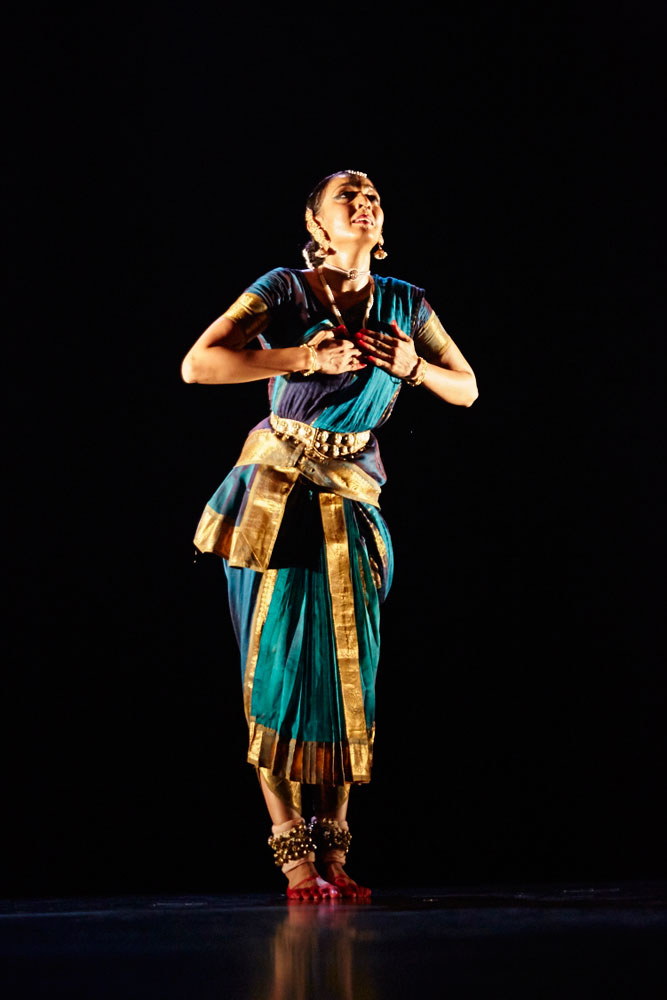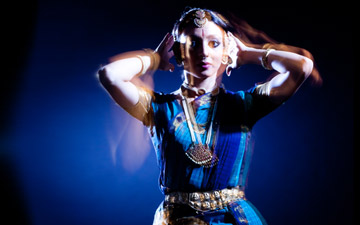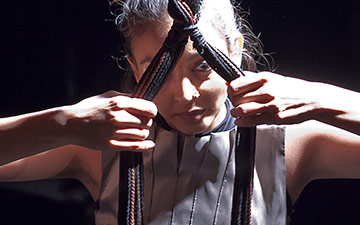
© Arnhel de Serra. (Click image for larger version)
Seeta Patel
Margam: A Classical Dance Recital
London, Purcell Room at Queen Elizabeth Hall
20 September 2015
www.seetapatel.co.uk
www.southbankcentre.co.uk
Margam is the first full-evening performance of bharatanatyam, the classical Indian dance form, from Seeta Patel. It’s an intimate and intense solo performance where the performer’s focus, commitment and artistry, supported by sympathetic interaction with her musicians, command the audience’s attention throughout. It was presented as part of Darbar, the festival of Indian music which is now in its 10th year at the Southbank, now for the first time including a dance element. The enthusiastic audience response to this sold-out show may mean that dance may have a more regular future role in this annual festival.
Seeta Patel has fascinatingly varied dance experience. She teaches as well as performs classical Indian dance, and you may recall her as one of the dance mentors and judges for the Indian strand of the BBC Young Dancer competition. However, she also has appeared in contemporary works including in 2011 DV8’s Can We Talk About This? which are some distance from the disciplines of classical form. The current programme at the Purcell Room, which she described as “a coming home”, grew out of last year’s Wild Card performances at the Lilian Baylis theatre at Sadler’s Wells, and includes newly-choreographed work from Seeta Patel and her teacher Mavin Khoo.
The theme of the five pieces of the evening is love and devotion, both sensual and spiritual. There is a strong narrative component in all the works, with Patel portraying multiple characters, switching from one to another. The longest item, and the core of the performance, is Varnam: Sakhiye Inda vElayil from last year. Here the three characters are the love-struck heroine (nayika), the god Krishna, and the heroine’s friend (sakhi) who she pleads with to bring the adored god to her.
This is a very refined and codified form of dance. It’s never a case of simply taking steps across the stage. A foot is raised and then perfectly placed in the exact, considered position. Patel shows exquisite control over the gesture of every splayed finger. She has wonderful command over her eyes and the direction of her gaze. In this piece she moves between the pleading lover and her friend and then suddenly morphs into Krishna himself, darting across the stage, firing his arrows. The yearning for the object of love becomes more than just physical but a longing for the divine.

© Arnhel de Serra. (Click image for larger version)
Bharatanatyam requires firm concentration from the audience as well as the performer. It was unfortunate that latecomers were admitted part-way through the first item. The modest scale of the Purcell Room, which was so appropriate for a solo performance, meant that this interruption was distracting for the audience, though Patel’s focus was unwavering. No wonder someone in my row thought that it was therefore OK to take out their phone and start filming. But though the dance requires close attention from viewers it is not remote or inaccessible. Translations of some of the devotional poems are provided in voiceover and in programme notes, and the narrative gestures, though stylized, are clear.
There was considerable charm too in one of the items in the second half of the bill, Padam (Enna Thavam) where we see Krishna’s mother putting her baby to bed and sweetly persuading him to sleep. In Padam (Ninnu Joochi) much of the performance is delivered by Patel in a seated position. She compels our attention through her eyes, her facial expressions and eloquent use of the arms.
As you would expect from a Darbar event, music is of great importance. Out in the buzzing foyer before the performance there was a well-attended free music recital followed with great attention which set the tone for the evening. In Margam music and the dancing are closely integrated. The bells on Patel’s ankles are part of the whole. There are five musicians present, Vanathi Bosch (conductor), Y Yadavan (the honey-toned vocalist), Senthuram Premakumar (percussionist), Madhusoodanan (flautist) and Achuthan Sripathmanathan (violinist). They sat in a line to one side of the stage, and if I have a quibble it would be that the view of the musicians from the side of the stalls was obstructed and it would have been a pleasure to see their playing much more clearly as well as hearing it.
This might imply that this was a performance that was traditional in all aspects, but there was a very modern element in the lighting design by Guy Hoare. This picked out slabs of light across the stage down which the dancer moved or sometimes backlit her form. This was much discussed in the interval and the ladies in the gloriously colourful saris who sat around me were wholly in favour of the extra drama that it injected and how it was used to pick out key poses.
This programme is a satisfying synthesis of classical music and dance from southern India, all from performers based in the UK. It is a remarkable achievement for Patel herself for her commanding and eloquent performance that carries an entire evening. It deserves to be seen more widely, and it is to be hoped that a proposed tour takes place this autumn.

















You must be logged in to post a comment.